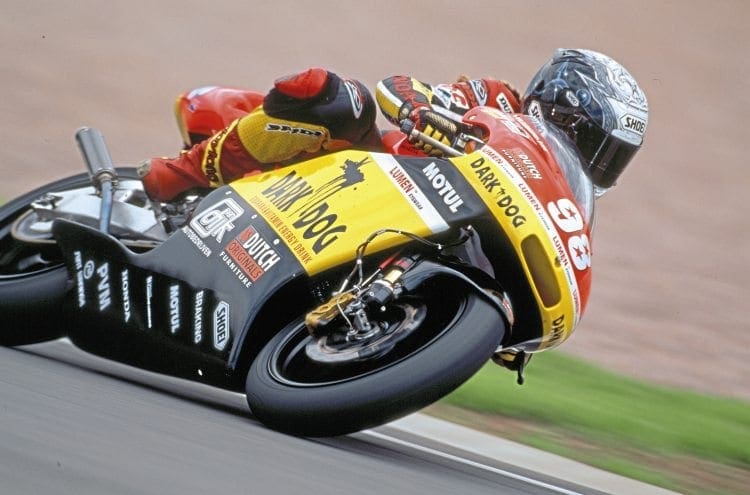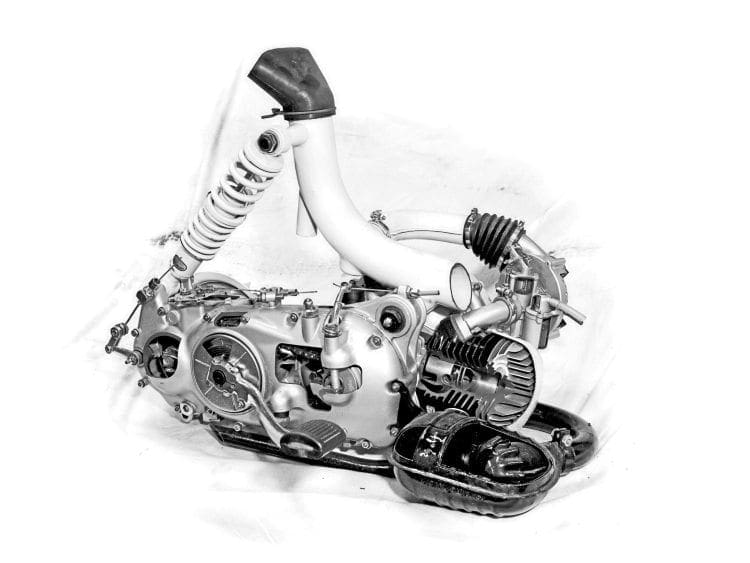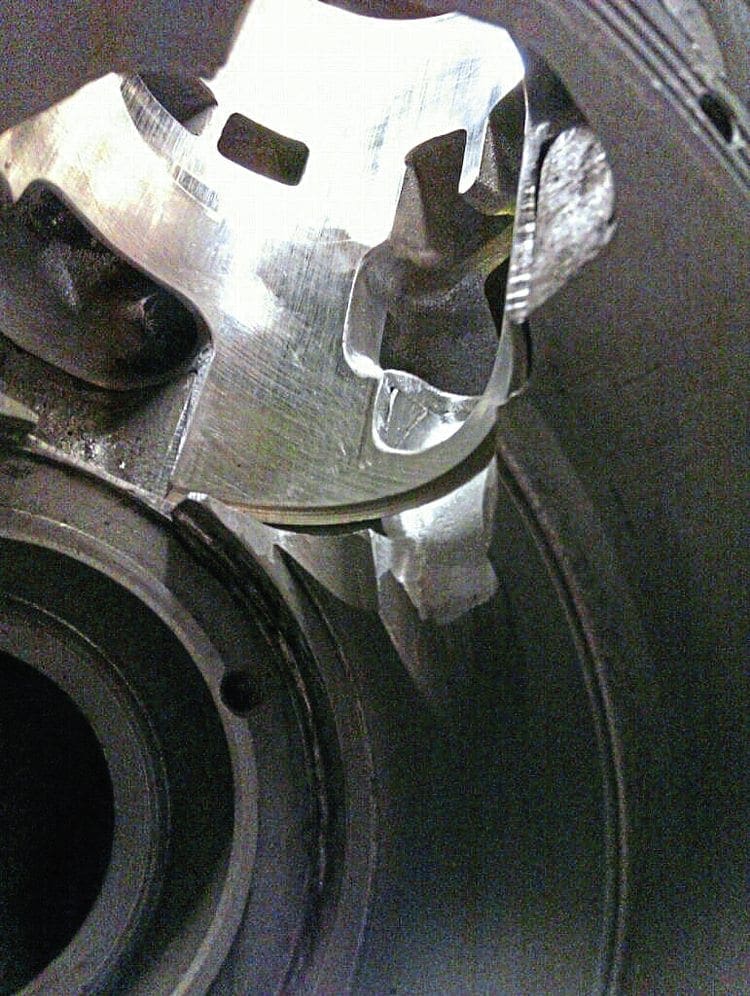Watching the leaps and bounds tuners and manufacturers have made with Lambretta and Vespa scooters over the past few years, the questions have to be asked: Where is ‘development’ taking us, what power figure is best, and what lessons can we learn from history?
Darrell Taylor investigates…

In the beginning God created the two-stroke… and he saw that it was good.
Take a minute to consider how far the humble two-stroke engine, fitted to the majority of the various scooters in current use, has progressed from its historical origins. Now consider that what has almost become the common performance expectation of today was once race track technology in years gone by. This technology has been progressively researched and developed over the decades to provide good performance in an often very reliable package.
These high-performing two-stroke engines can now happily share the road and hold their own with other modern vehicles at current speed limits, and be expected to maintain those enhanced speeds and durations which they are held at on the dual carriageways which they often travel upon. These achievements are quite miraculous when you consider the two-stroke-powered scooter’s original intended use as a village or town commuter vehicle. The engine build considerations at the time were mostly based around low-powered units not exceeding 10bhp at a low operating speed of around 6500rpm. These engines were built to do the job in hand and provide long life with extended service intervals, like those you see modern manufacturers striving for in the two- and four-wheelers they produce today.
Real world power limits
Pause for thought — at what point will two-stroke development peak? Allow me to share a little bit of historical data from various sources to improve our understanding of what we had (and have) in terms of performance. Using that data and industry calcs, we can then evaluate what has gone before us to see where they suggest the performance threshold is.
A method of comparing all engines’ performance has been established within the industry and given the term BMEP, meaning Brake Mean Effective Pressure. It allows us to evaluate the likelihood of performance possibilities of future designs when combined in a comparison table with similar engine types/cc/operating rpm, be they from the past or present. When combined with future designs, it can allow us to set ourselves realistic and sustainable figures as our goals.
So where can we find this data? Lambretta produced its models over a long period of time but then it had longevity in mind well above performance — until the marketing men saw a performance based niche that could be easily filled with a few cc extra and a tweak here and there. This gave a step up from the original performance but development stopped at that point and the increases seen were not sizeable.

Other two-wheel manufacturers were growing rapidly, especially the ‘big four’ from Japan: Honda, Yamaha, Suzuki and Kawasaki. All of these companies had a large range of two-stroke machines which covered a whole host of engine sizes, but also engine types that covered commuter/ tourer/sporting/trial/trail/MX/road-racing. Huge development budgets were the order of the day back then, in order to fulfil the requirement to constantly beat each other, year on year, to attract customers. This meant that development was fast and the data these machines left behind becomes very useful right up to today. Lots of these machines also became parts donors for developers and racers at the time and still do to this day, to use in their scooters on both road and track, so you may well recognise the models covered!
Year-on-year, the big four developed and improved their product ranges, but it is noticeable when reading through the history of various models that the odd glitch appears here and there which shows that improvements in one area can result in losses in others. Then you can see the innovative trends that followed, to take advantage and recoup the losses, examples like reed valves, advance/retard ignition, Yamaha energy induction system (boost bottle), liquid cooling, power valve systems, power jets, solenoid operated power jets, six gears with closer ratios etc.
These magnificent and well researched items all become commonplace on most models to offset the losses caused by higher port timings, peakier pipe designs, larger blow-down, heavy triple and bridged port designs which resulted in higher peak power, but significant bottom end power losses also. Other areas like kart, quad, snowmobile and jet ski designs also provide development insights and many designs reversals, like returning back to single ex-ports to assist shaping a power curve, in order to achieve a more desirable result… especially where the other innovative trends cannot be utilised.
The maths of BMEP
Back to BMEP: for ease of quoting, and obtaining the data, I’ve calculated it from bhp and rpm figures which are fine to use as a yardstick, and are more common in lots of computer programs, but is usually calculated from torque/rpm figures. The results are produced in bar or psi; in this exercise I shall quote bar.
Let’s look at Lambretta BMEP. An original Lambretta SX200 which I dynode and published a graph for in an earlier ‘Bang for Buck’ article (Scootering May 2016, p112) produced 8.9bhp at 6600rpm, this gives a baseline BMEP figure of 3.02 bar.
By the end of the article, as a tuned SIL200, it was 22.93bhp at 6200 giving a BMEP figure of 8.29 bar. Quite similar to where a common time-served TS1 set up would be, although the TS1 would be 225cc and around 22bhp at 7500rpm on average, this gives us a BMEP of 5.84 bar. By comparison, a well-built RB250 (actually 244cc) sits around 28bhp at 8000rpm, giving a BMEP of only 6.27 bar.
Now we turn to air-cooled 80s Jap BMEP. Back to the 1980s and taking a look through Yamaha’s two-stroke range, this provides the following information from the common road-going MX styled DT range:
| Yamaha DT125 | 14bhp | 6500rpm | BMEP = 7.72 bar |
| Yamaha DT175 | 16bhp | 7000rpm | BMEP = 5.85 bar |
| Yamaha DT250 | 18.2bhp | 6000rpm | BMEP = 5.44 bar |
Moving on the slightly more highly developed Yamaha IT air-cooled range of road-leagl endure bikes, the engine’s basic design remains the same but with a host of modifications such as different porting/compression/pipe/carb etc. to enhance the power for this application, with an acceptance from the owner that it is going to require increased maintenance etc.
| Yamaha IT125 | 17bhp | 9000rpm | BMEP = 6.77 bar |
| Yamaha IT175 | 21.5bhp | 9500rpm | BMEP = 5.8 bar |
| Yamaha IT200 | 27.6bhp | 9000rpm | BMEP = 5.5 bar |
| Yamaha IT250 | 32.2bhp | 7500rpm | BMEP = 7.65 bar |
This is quite interesting as it shows how the IT125 and 175 models have higher bhp power figures than the equivalent DT, but only do so from the rpm increase, thus making them less efficient than their DT stablemate, which can be identified in the BMEP figures.
Next is the thoroughbred YZ race models, with just two models – a 125 and 250 – to compare. The last of the air-cooled motocross motors appeared around 1980 and at these types of power outputs they found it a struggle to maintain their power throughout a race. Future power developments were therefore a pointless exercise. All four major manufacturers then switched from air-cooled, to liquid-cooled at this crucial point in power/reliability research.
| Yamaha YZ125 | 26.5bhp | 11,000rpm | BMEP = 8.64 bar |
| Yamaha YZ250 | 34bhp | 7800rpm | BMEP = 7.81 bar |
Entering the era of liquid-cooled 1990s BMEP, more specifically looking at Kawasaki in 1992, we can see how the motors of the time have progressed with the reduced number of two-stroke models appearing in the model line-ups offered by the big four. Not only that, those that are available are by now mostly occupying motorcross and endure roles and taking advantage of liquid cooling, power valves etc. The quoted Kawasaki figures are a lot higher than seen in reality and are crank bhp figures, so I’ve deducted 10% to make a rear-wheel adjustment figure, and that gets the KX125 figure close to what I have seen before on a new model on my own dyno. The Kawasaki enduro model KDX, like the Yamaha IT range, is designed as a crossover bike from road to track or ‘green-laner’.
| KDX200 | 31.5bhp | 8000rpm | BMEP = 8.82 bar |
| KDX250 | 36bhp | 7500rpm | BMEP = 8.6 bar |
Kawasaki motocross KX model:
| KX125 | 35.1bhp | 11,250rpm | BMEP = 11.19 bar |
| KX250 | 47.7bhp | 8500rpm | BMEP = 10.06 bar |
Other worthy of nore that sit between the 1990s and now are:
| Honda CRM250AR enduro | 40bhp | 8000rpm | BMEP = 8.96 bar |
| Suzuki TS200R enduro | 35bhp | 8500rpm | BMEP = 9.23 bar |
| Suzuki RMX250 enduro | 40bhp | 8000rpm | BMEP = 8.96 bar |
Modern BMEP
And now we move on to the present and the YZ250. Introduced in 1974, it’s still produced today with only minor updates made in recent years.
In terms of BMEP, the YZ250 makes 9.94 bar with 48.8bhp and 8800rpm. I had the pleasure of dynoing this impressive power plant last month. It produced 49.6bhp while fitted in Jason Potter’s Lambretta special. The road legal Aprilia RS125 with its liquid-cooled, power-valved, Rotax power plant in its first full-power guise made 33bhp at 11,000rpm giving a BMEP of 10.76. In a later, lower-powered, 28mm carb guise which sold in bigger numbers to the mass market it made 28bhp at 10,500rpm giving a BMEP figure of 9.56 bar.
The recently produced BSG Vespa 305 motor made 51bhp at 8841rpm giving a BMEP of 8.48 bar. This is surprisingly low, indicating there’s potentially more to follow should the desire be there. Moving onto GP bikes in the form of Honda’s GP125, they quote 42bhp but I’ve never seen that, the usual figure being nearer 38bhp on a well sorted machine, which at 12,000rpm gives a BMEP figure of 11.35.
So what can we see from the figures when grouped?
| Standard Lambretta SX200 air-cooled road commuter | 3.02 bar |
| Lambretta TS1 225cc air-cooled | 5.24 bar |
| Lambretta RB250 244cc air-cooled | 6.27 bar |
| SIL 200 tuned ‘bang for buck’ air-cooled motor | 8.29 bar |
| BSG Vespa 305 | 8.48 bar |
| Yamaha DT250 80s air-cooled road bike | 5.44 bar |
| Yamaha IT250 80s air-cooled enduro | 7.65 bar |
| Yamaha YZ250 80s air-cooled motocross | 7.81 bar |
| Kawasaki KDX 250 liquid-cooled enduro | 8.6 bar |
| Honda CRM250AC liquid-cooled enduro | 8.96 bar |
| Suzuki RMX250 liquid-cooled enduro | 8.96 bar |
| Yamaha IT200 80s air-cooled enduro | 5.5 bar |
| Kawasaki KDX200 90s liquid-cooled enduro | 8.82 bar |
| Suzuki TS200R 90s liquid-cooled enduro | 9.23 bar |
| Yamaha YZ250 90s liquid-cooled motocross | 9.94 bar |
| Kawasaki KX 250 90s liquid-cooled motocross | 10.06 bar |
| Yamaha DT125 80s air-cooled road bike | 7.72 bar |
| Yamaha IT125 80s air-cooled enduro | 6.77 bar |
| Yamaha YZ125 80s air-cooled motocross | 8.64 bar |
| Aprilia RS125 road going Hyper 125 28mm | 9.56 bar |
| Aprilia RS125 road going Hyper 125 34mm | 10.76 bar |
| KX125 90s liquid-cooled motocross | 11.2 bar |
| Honda RS125 GP bike | 11.35 bar |
But what does it all mean?
The BMEP figures work as performance indicators, and as a result they tell us about a motor’s state of tune, be it an underdeveloped workhorse or a high-end Grand Prix model. Combine with these a manufacturer’s evolution history, and it gives us an insight into the cut-off points they reached during this process. In most cases the 90s water-cooled road/enduro motors have matched or bettered the performance of the 80s air-cooled machines. In the 125 section, it’s easy to see performance level groups as we progress from air-cooled to liquid-cooled, road to on/off road, and then through to full race engines in ranges from 7-11 bar motocross models.
The durable 80s air-cooled road bikes were at 5.4 to 7.6 bar and sporting road/enduro models which tie in nicely and compare with the known/durable Lambretta TS1225 at 5.24 bar and the RB250 kit at 6.27 bar with a similar horsepower level to the similar capacity motorcycles. This answers our initial question of how good the current scooter engines are, but also explains why when left at around this level, they can safely tour Europe and clock up some high miles between service schedules.
At the end of its development the ‘Bang for Buck’ motor was above 8 bar, on a cast cylinder too, which is a stage too far in terms of durability when using the above indicators. It would be better taken out to a larger cc like 225 while retaining the same power — reducing it to a safer BMEP level like the TS1. The RB250 (244cc) has a low 6.27 BMEP, suggesting it has good tuning potential, which if pushed to say a BMEP of 8 bar would result in 35bhp, which has been shown to be reliable at that level.
The 80s air-cooled motocross, in particular the last 250cc models, represent the cut-off point in air-cooled development, sitting at just below 8 bar BMEP. Browsing through an old motocross catalogue I found around 10 models from the era, including big European players like KTM, Maico, and Husqvarna… all with a quoted 33-36bhp range. This ties in well with the type of performance seen from most circuit racing GP6 Lambrettas, with some GP6 scooters up around the 40bhp point, which means they will also have the accompanying levels of service and reliability which you would expect to go hand in hand with these higher figures, should you want to use them on the road.

The air-cooling of 80s motocross machines meant that they had to utilize huge fin cylinders with large heads to match, and were for race use. They worked hard at low speeds in muddy environments and that will not have helped their cause. Scooters with reduced fin areas, but an efficient fan and cowl design, may just be able to match the cooling they offered.
The last 250 road/enduro machines from Honda and Suzuki, at around 9 bar, came with liquid-cooling and every other trick in the book to keep them reliable. All big four manufacturers settled for 40bhp as their feasible maximum, taking into consideration intended use, lifespan, and service intervals, leaving 10 bar and above figures for just their full race and extreme motocross models.
So from the above we can assume the below figures as being safe maximums within each category, that history has shown us to be true, as tested, developed and produced by the big four (and others). Should a two-stroke, air-cooled engine like the Lambretta or Vespa be pushed beyond these boundaries for air/liquid cooled types and road/race brackets, then history does not favour the outcome.
| Air cooled road-standard | 7 bar |
| Air cooled road-tuned | 8 bar |
| Water cooled road-tuned | 9 bar |
| Water cooled race-MX | 10 bar |
| Water cooled race-GP | 11 bar |
Next month we will cover predicted lifespans and service intervals of motors at different power levels and BMEP ranges — it’s quite an alarming read. Plus we look at what considerations a scooterist might want to make when selecting their next engine. Stay tuned.
Words: Darrell Taylor
Photos: Mark Wernham Collection at Mortons Archive & Mortons Archive



